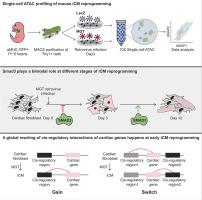Journal of Molecular and Cellular Cardiology ( IF 4.9 ) Pub Date : 2021-09-10 , DOI: 10.1016/j.yjmcc.2021.09.002 Haofei Wang 1 , Yuchen Yang 1 , Yunzhe Qian 1 , Jiandong Liu 1 , Li Qian 1

|
Direct conversion of cardiac fibroblast into induced cardiomyocytes (iCMs) by forced expression of cardiac transcription factors, such as Mef2c, Gata4, and Tbx5 (MGT), holds great promise for regenerative medicine. The process of cardiac reprogramming consists of waves of transcriptome remodelling events. However, how this transcriptome remodelling is driven by the upstream chromatin landscape alteration is still unclear. In this study, we performed single-cell ATAC-seq (Assay for Transposase-Accessible Chromatin using sequencing) on early reprogramming iCMs given the known epigenetic changes as early as day 3. This approach unveiled networks of transcription factors (TFs) involved in the early shift of chromatin accessibility during cardiac reprogramming. Combining our analysis with functional assays, we identified Smad3 to be a bimodal TF in cardiac reprogramming, a barrier in the initiation of reprogramming and a facilitator during the intermediate stage of reprogramming. Moreover, integrative analysis of scATAC-seq with scRNA-seq data led to the identification of active TFs important for iCM conversion. Finally, we discovered a global rewiring of cis-regulatory interactions of cardiac genes along the reprogramming trajectory. Collectively, our scATAC-seq study and the integrative analysis with scRNA-seq data provided valuable resources to understand the epigenomic heterogeneity and its alteration in relation to transcription changes during early stage of cardiac reprogramming.
中文翻译:

在直接心脏重编程的早期阶段描绘染色质可及性在单细胞水平上的重新模式化
通过强制表达心脏转录因子,如 Mef2c、Gata4 和 Tbx5 (MGT),将心脏成纤维细胞直接转化为诱导性心肌细胞 (iCM),对再生医学具有广阔前景。心脏重编程过程由转录组重塑事件的波浪组成。然而,这种转录组重塑是如何由上游染色质景观改变驱动的仍不清楚。在这项研究中,考虑到早在第 3 天就已知的表观遗传变化,我们对早期重编程 iCM 进行了单细胞 ATAC-seq(使用测序分析转座酶可及染色质)。这种方法揭示了转录因子 (TF) 网络参与心脏重编程过程中染色质可及性的早期转变。将我们的分析与功能分析相结合,我们确定 Smad3 是心脏重编程中的双峰 TF,是重编程启动的障碍和重编程中间阶段的促进剂。此外,scATAC-seq 与 scRNA-seq 数据的综合分析导致识别对 iCM 转换很重要的活性 TF。最后,我们发现了沿着重编程轨迹的心脏基因的顺式调控相互作用的全局重新布线。总的来说,我们的 scATAC-seq 研究和 scRNA-seq 数据的综合分析为了解表观基因组异质性及其在心脏重编程早期阶段与转录变化相关的改变提供了宝贵的资源。scATAC-seq 与 scRNA-seq 数据的综合分析导致识别对 iCM 转换很重要的活性 TF。最后,我们发现了沿着重编程轨迹的心脏基因的顺式调控相互作用的全局重新布线。总的来说,我们的 scATAC-seq 研究和 scRNA-seq 数据的综合分析为了解表观基因组异质性及其在心脏重编程早期阶段与转录变化相关的改变提供了宝贵的资源。scATAC-seq 与 scRNA-seq 数据的综合分析导致识别对 iCM 转换很重要的活性 TF。最后,我们发现了沿着重编程轨迹的心脏基因的顺式调控相互作用的全局重新布线。总的来说,我们的 scATAC-seq 研究和 scRNA-seq 数据的综合分析为了解表观基因组异质性及其在心脏重编程早期阶段与转录变化相关的改变提供了宝贵的资源。











































 京公网安备 11010802027423号
京公网安备 11010802027423号